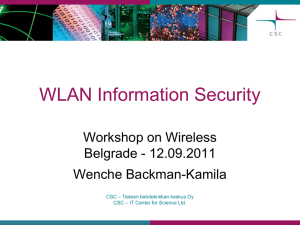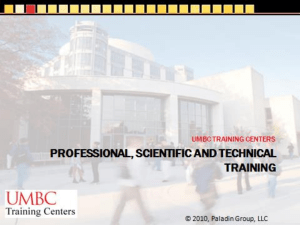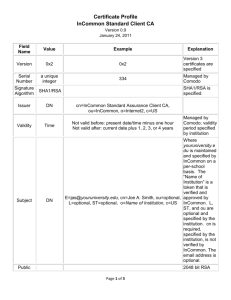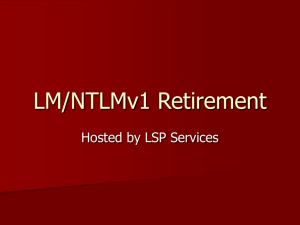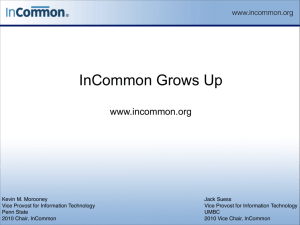INT2 ISSUES - JKrienke and AWest - 25SEP2013
advertisement
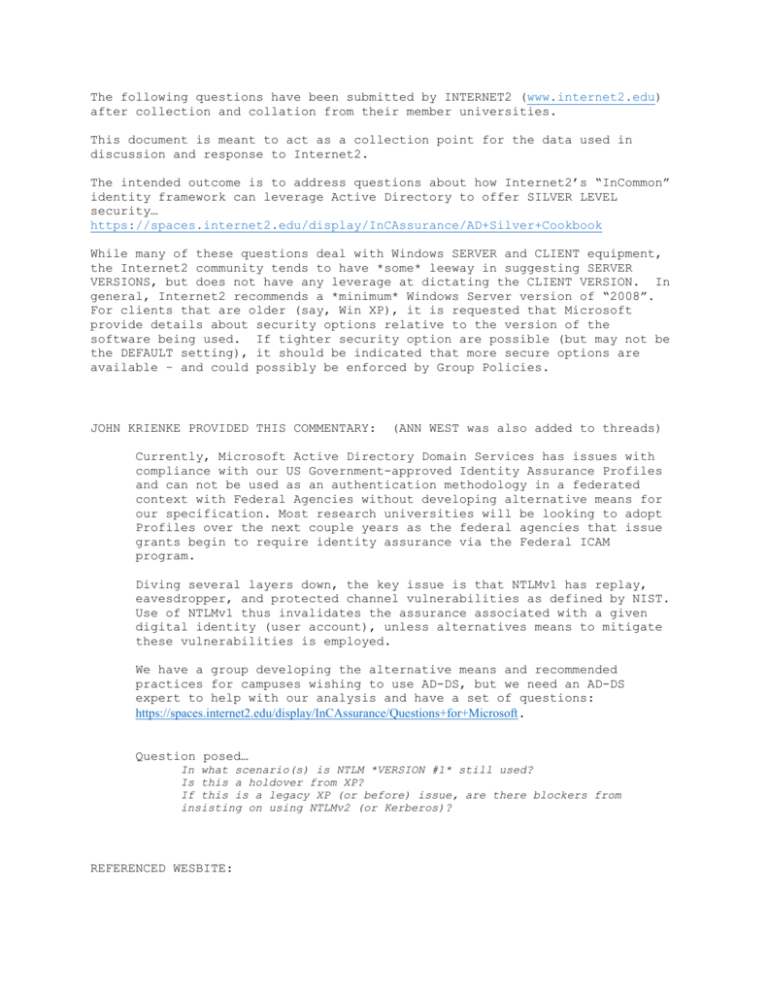
The following questions have been submitted by INTERNET2 (www.internet2.edu)
after collection and collation from their member universities.
This document is meant to act as a collection point for the data used in
discussion and response to Internet2.
The intended outcome is to address questions about how Internet2’s “InCommon”
identity framework can leverage Active Directory to offer SILVER LEVEL
security…
https://spaces.internet2.edu/display/InCAssurance/AD+Silver+Cookbook
While many of these questions deal with Windows SERVER and CLIENT equipment,
the Internet2 community tends to have *some* leeway in suggesting SERVER
VERSIONS, but does not have any leverage at dictating the CLIENT VERSION. In
general, Internet2 recommends a *minimum* Windows Server version of “2008”.
For clients that are older (say, Win XP), it is requested that Microsoft
provide details about security options relative to the version of the
software being used. If tighter security option are possible (but may not be
the DEFAULT setting), it should be indicated that more secure options are
available – and could possibly be enforced by Group Policies.
JOHN KRIENKE PROVIDED THIS COMMENTARY:
(ANN WEST was also added to threads)
Currently, Microsoft Active Directory Domain Services has issues with
compliance with our US Government-approved Identity Assurance Profiles
and can not be used as an authentication methodology in a federated
context with Federal Agencies without developing alternative means for
our specification. Most research universities will be looking to adopt
Profiles over the next couple years as the federal agencies that issue
grants begin to require identity assurance via the Federal ICAM
program.
Diving several layers down, the key issue is that NTLMv1 has replay,
eavesdropper, and protected channel vulnerabilities as defined by NIST.
Use of NTLMv1 thus invalidates the assurance associated with a given
digital identity (user account), unless alternatives means to mitigate
these vulnerabilities is employed.
We have a group developing the alternative means and recommended
practices for campuses wishing to use AD-DS, but we need an AD-DS
expert to help with our analysis and have a set of questions:
https://spaces.internet2.edu/display/InCAssurance/Questions+for+Microsoft.
Question posed…
In what scenario(s) is NTLM *VERSION #1* still used?
Is this a holdover from XP?
If this is a legacy XP (or before) issue, are there blockers from
insisting on using NTLMv2 (or Kerberos)?
REFERENCED WESBITE:
Background
On October 6, 2011, Steven VanRoekel, the Federal Chief Information Officer, issued a memorandum
(http://www.howto.gov/sites/default/files/omb-req-externally-issued-cred_0.pdf), specifying a timetable for
federal agencies to begin leveraging externally-issued credentials. The Federal Identity, Credential, and
Access Management Subcommittee (FICAM - http://www.idmanagement.gov/pages.cfm/page/ICAM) is
named as responsible for certifying the entities that may issue such credentials.
InCommon (http://www.incommon.org) is a Trust Framework Provider, certified by FICAM under the Trust
Frame Provider Adoption Process (TFPAP http://www.idmanagement.gov/documents/FICAM_TFS_TFPAP_v1.1.0.pdf) at assurance levels 1
(InCommon Bronze) and 2 (InCommon Silver). As a certified trust framework provider, InCommon is
authorized to certify campuses to issue identity assertions over the Internet to government agency service
providers at assurance levels 1 and 2. The documents governing InCommon's trust framework are
available at http://www.incommon.org/assurance/components.html; of particular relevance here is
"Identity Assurance Profiles - Bronze and Silver" (IAP http://www.incommon.org/docs/assurance/IAP.pdf).
The InCommon Assurance Program is currently sponsoring a group of university representatives who are
exploring means that can be used to certify for InCommon Silver when password credentials used for
Silver-level authentication are stored in an Active Directory instance. "IAP Requirements and Gaps for
Active Directory Domain Services" (https://spaces.internet2.edu/x/BA8wAg) is a brief summary of that
work.
Finally, universities are "BYOD" environments. While standards for end-user devices are often
established, typically little enforcement is exercised over the types and configuration of devices that may
be used to access services. It is important that services be capable of protecting themselves from noncompliant end-user behavior.
Questions
1. Protected Channels - IAP 4.2.3.6.1b - Gaps (Addresses channels used between DC’s, as well as
DC’s AD storage of passwords on disk and in memory.)
a. RC4 HMAC encryption is not NIST or FIPS approved, and we would like to determine if
it's comparable to those methodologies that are. Can you help with this? (See
http://www.incommon.org/assurance/alternativemeans.html for the criteria we will
consider.) RC4 HMAC is not considered a suitable encryption method moving forward,
and its use within future deliverables is not practical. Per Microsoft Crypto Standard
Procedures, stream ciphers such as RC4 HMAC should be replaced with block ciphers
such as AES with a minimum key length of 128 bits. UPDATE: after discussing with the
AD-Assurance Team from Internet2, the issue arises from the method used by AD to
store user credentials. Some clients may be locked at a given version – say Windows CE
or XP embedded running in a client’s monitoring device or medical equipment (as an
example). Internet2 is seeking SILVER level service, which entails NIST approved
algorithms for encryption. NIST Pub 800-118 “Guide to Enterprise Password
Management” defers to FIPS-approved algorithms. FIPS 140-2 has an appendix:
“Annex A: Approved Security Functions for FIPS 140-2, Security Requirements for
Cryptographic Modules”. The specific question around “sChannel” support is noted as
FIPS-approved per TechNet FIPS documentation at http://technet.microsoft.com/enus/library/cc750357.aspx.
b. Currently, it is not very practical to crack RC4 HMAC, even though it has long-known
vulnerabilities. If that were to change (e.g., a simple crack program posted on the
Internet), does Microsoft have a response procedure for such compromises? How will
this procedure protect Microsoft's customers that may be operating at LoA-2 via an
alternate means exception? Microsoft operates a vulnerability reporting mechanism via
the Microsoft Security Response Center (MSRC). This website documents the
methodology of reporting, tracking and responding to any such vulnerability.
c. What encryption algorithms does Windows Secure Channel use? Based upon the user’s
settings, the ALG_ID can be assigned to include settings such as 3DES, two-key 3DES
@ 112bits, AES, AES @ 128bits, AES @ 192bits, AES @ 256bits, mutually-agreed
algorithm via Diffie-Hellman, etc. More details on algorithm choices @
http://msdn.microsoft.com/en-us/library/windows/desktop/aa375549(v=vs.85).aspx. Note
that of these, only AES is considered strong and is approved. Also, if your definition of
“encryption” for this question extends to asymmetric encryption/key exchange, SChannel
also supports RSA, DH and ECDH. All of these are SDL-approved.
d. What's the impact of turning on the FIPS setting on all Domain Clients? What's the
impact on Domain Controllers? As with any cryptographic session, establishing a FIPSsecured communication session is a mathematically-intense operation. Given the nature
of algorithms choices, and various key lengths, the exact impact of any given encryption
selection is dependent upon the client hardware and the server hardware, plus the overall
load applied to the server. While it is not feasible to outline all of the permutations of
varied client hardware and server hardware, the FIPS settings and config data can be
referenced at: http://support.microsoft.com/kb/811833. Also refer to the THREATS AND
COUNTERMEASURES GUIDE @ http://www.microsoft.com/enus/download/confirmation.aspx?id=26137
2. What should one do to enable distinguishing between NTLM v1 and v2 in the logs? We would like
to downgrade a user's assurance level if they access a service that employs NTLM v1.
a. In the SECURITY LOG, you have to inspect the Detailed Authentication Information
section:
Log Name:
Security
Source:
Microsoft-Windows-Security-Auditing
Event ID:
4624
Task Category: Logon
Level:
Information
Keywords:
Audit Success
Description:
3.
4.
5.
6.
7.
8.
9.
An account was successfully logged on.
Account Name:
user
Account Domain: contoso
Detailed Authentication Information:
Logon Process:
NtLmSsp
Authentication Package:
NTLM
Transited Services:
Package Name (NTLM only):
NTLM V1
When BitLocker full disk encryption is used are disk sectors decrypted only as they are
read? What is the recommended/supported BitLocker configuration for use with AD-DS?
Reference for BL and AD: http://technet.microsoft.com/en-us/library/cc766015(v=ws.10).aspx
UPDATE: the BitLocker question arise from a recommendation (albeit, misguided) from NIST
that it would add tighter security around the storage of credentials on a domain controller. The
desired outcome would be to strengthen the security of AD credential storage on disk and in
memory. This could be reflected by the NTLM version in use – seeking to implement an
approved algorithm such as AES-128, etc.
Does Syskey use NIST/FIPS Approved Algorithms for encryption? The algorithm used within
SysKey is not published. SysKey does provide levels of relative security, with a systemgenerated password used and stored on a startup key.
Are AD-DS password credentials stored by other Microsoft identity management components,
such as ADFS? If so, what are those components? UPDATE: since the goal is to provide a
single sign-on ecosystem, if a user authenticates with their single username/password credentials
(the same creds that could be used to login to a secure government R&D server, for example) –
how can we account for any storage of those credentials within our systems? As an example – if
you use something like IMAP to connect to an Exchange Online service, you would likely use
NTLMv1 authentication, which does not meet NIST standards.
Does Microsoft have a strategy for supporting compliance with the Federal Identity, Credential,
and Access Management (FICAM) requirements at LoA-2, perhaps through Microsoft's
partnership with the Kantara Initiative? If so, what is the time frame? NO UPDATE AVAILABLE
AT THIS TIME.
Does Microsoft have a strategy for AD integration of non-Windows and old-Windows client
platforms that will use NIST/FIPS approved algorithms for transport of passwords over a
network? If so, what is the time frame? Making sure that I am understanding the intent … the
goal would be to maintain AD as an IdP for clients that transmit password encrypted using NIST
algorithms? THIS TOPIC IS UNDER INVESTIGATION. (If the understanding is incorrect, please
advise.)
Is it possible to configure AD so that the NetUserChangePassword and NetUserSetInfo protocols
require NIST approved algorithms for encrypting the session over which the password data is
passed? THIS TOPIC IS UNDER INVESTIGATION.
Please review "IAP Requirements and Gaps for Active Directory Domain Services" to verify the
information it contains. [Content from this link pasted below.] Storage security of credentials in
the SAM can be augmented using SysKey. Please advise if this is a suitable method, given that
cracking the SAM requires some elevated privileged access to the system already.
IAP REQUIREMENTS AND GAPS FOR ACTIVE DIRECTORY DOMAIN SERVICES
IAP Requirements and Gaps for
Active Directory Domain Services (AD-DS)
Added by Eric Goodman, last edited by BRIAN ARKILLS on Apr 26, 2013 (view change)
view
IAP v1.2 Section
Requirements
AD-DS Baseline
(paraphrased)
Controls
4.2.3.4 - Stored
Do not store
Passwords are stored
Authentication
passwords as
in the ntds.dit file. They
Secrets (S)
plaintext. Limit
are not stored as
access to admins
plaintext. The operating
and apps that
system normally
require access.
prevents access to the
Baseline Gaps
No gaps.
file.
Protect stored
1. The "NT hash" is an
1. MD4 is not an Approved Algorithm and a
passwords with one
unsalted MD4 hash. The
variable salt is not employed.
of the following
"LM hash" isn't a
alternatives:
cryptographic hash.
1. Concatenate a
variable salt to the
password and hash
with an Approved
Algorithm.
2. Encrypt the
2. Encrypts the "NT
2. DES and RC4 are not Approved
password with
hash" with DES and the
Algorithms.
an Approved
users RID, then encrypts
Algorithm and
again with RC4 and the
Full-disk encryption (FDE) solutions
decrypt only when
PEK. The "LM hash"
(hardware or software) that utilize Approved
immediately needed
is the output from
Algorithms and only decrypt passwords
for authentication.
encrypting a constant
when immediately needed (i.e. decrypt disk
with the password and
sectors as needed to support read operations
DES.
while keeping the data on disk
encrypted) provide a compensating control.
Bitlocker2 is an example FDE solution that
ships with Windows 2008 and newer.
AM
Remaining
Proposal
Gaps
3. Any method
allowed for NIST
800-63 Level 3 or 4.
4.2.3.5 - Basic
1. Do not store
1. Passwords are stored
Protection
passwords as
in the ntds.dit file. They
of Authentication
plaintext. Limit
are not stored as
Secrets (B)
access to admins
plaintext. The operating
and apps that
system normally
require access.
prevents access to the
1. No gaps
file.
2. Do not transmit
2. Authentication
2. LDAP without SSL5 transmits plaintext
plaintext passwords
using LM, NTLMv1,
passwords. Enforcing LDAP signing4
over the network
NTLMv2, LDAP over
prevents LDAP connections without SSL, but
5
6
SSL , or Kerberos does
this may cause compatibility issues with
not transmit cleartext
some clients (e.g. Mac and Linux clients
passwords.
using Samba).
1a. See the relevant sections in this table.
4.2.3.6 - Strong
1a. Any credential
1a. See the relevant
Protection of
store with
sections in this table.
Authentication
passwords used by
Secrets (S)
the IdP or verifier is
subject to 4.2.3.4
and 4.2.8.
1b. Use Protected
1b. AD-DS uses RPC
Channels when
and Kerberos when
passwords are sent
synchronizing between
from one credential
domain controllers. For
store to another.
Windows Server 2008
There may be implementation specific issues
and later, AES is used
based on local technology choices for
for Kerberos encryption if
password provisioning. These issues are not
properly configured.1
specific to AD-DS.
Alternatively, an
appropriately configured
mechanism such as
IKE/IPSEC may be used
to create the Protected
Channel.
This requirement also
applies to provisioning of
passwords into or out of
AD-DS.
1b. Gaps?
2. Use Protected
2. Verification using
6
2. Use of LM and NTLMv1 protocols may be
Channels when
NTLMv2, Kerberos , or
prevented by disabling the protocols centrally
passwords are sent
LDAP with SSL5 uses a
at the AD-DS. Disabling these protocols may
between services
protected channel
cause compatibility issues with older
for verification
between services. Use of
applications3. Enforcing LDAP signing4
purposes.
LM and NTLMv1
prevents unsigned LDAP connections by
protocols for verification
using SSL. As mentioned above, this may
is precluded by subjects
cause compatibility issues depending on the
holding a Silver IAQ due
environment.
to the definition of a
protected channel. Use
of LDAP without SSL is
also precluded for the
same reason.
3. Have policies
3. AD-DS is considered
3. A general principle of following the
and procedures
part of the IdMS when
password and applying risk management at
to minimize the risk
included in an assurance
any point where the protected channel
of transient
assessment, Since AD-
between the subject and the verifier is
password exposure
DS can act as a verifier
compromised should be applied. Common
to non-IdP apps.
for non-IdP applications
examples that require additional attention are
that exist outside of
non-privacy perserving authentication
IdMS, the organization
interfaces, externally hosted applications and
as IdPO must have
applications that
policy in place to enforce
require proprietary authentication API's.
the IAP requirements for
Involving Information Security, Audit
any application that
and Procurement staff would be
password transits
recommended.
through between subject
and AD-DS.
4.2.5.1 - Resist
Ensure it's
Windows maintains a
LM - Does not resist replay attacks*
Require
Replay Attack (B,
impractical to
cache of used
NTLMv1 - Does not resist replay attacks*
LDAP
S)
achieve
authenticators to allow it
NTLMv2 - Resists replay attacks7
signing
authentication by
to recognize a replay of a
LDAP - Does not resist replay attacks if LDAP
recording and
specific authentication
signing4 is not enforced
replaying a previous
event.
Kerberos - Resists replay attacks7
authentication
message.
* Not allowed per AD Silver Cookbook
OR
Enable
LDAP
signing and
monitor &
mitigate
non-LDAP
signed use
by those
with an
assurance
level.
4.2.5.2 - Resist
Ensure it's
LM, NTLMv1, NTLMv2
LM - Vulnerable to eavesdropping*
1. Use
Eavesdropper
impractical to learn
and Kerberos all provide
NTLMv1 - Vulnerable to eavesdropping*
protected
Attack (B, S)
the password or
some level of security
NTLMv2 - Resists eavesdropping (strength of
channel
otherwise obtain
based on their native
encryption)7
(e.g., VPN)
information that
encryption. Strength of
LDAP - Vulnerable to eavesdropping if LDAP
would allow
encryption determines
signing4 is not enforced
impersonation of a
how well the protocol
Kerberos - Resists eavesdropping7
subject by network
resists eavesdropping.
* Not allowed per AD Silver Cookbook
eavesdropping.
LDAP
Fails to resist
eavesdropping if using
Simple Binds without
TLS/SSL.
Simple Binds with
TLS/SSL5 or signing
should resist
eavesdropping.
Binds using SASL (and
not TLS/SSL) will use the
native encryption of the
underlying SASL
mechanism (LM, NTLM,
etc).
4.2.8.2.1 - Network
Protected
For native IdMS
Security (S)
Channels should
components (AD Domain
be used for
Controllers), replication is
communication
described above in
between IdMS
4.2.3.6, 1b.
As 4.2.3.6., 1b.
systems.
Not clear that other IdMS
are relevant, in that they
will not be native AD
components. *
* Assumes that AD-LDS
replication is the same as
AD-DS replication.
Definitions from the Identity Assurance Assessment Framework:
Approved Algorithm - Any implementation of an algorithm or technique specified in a FIPS
standard or NIST recommendation, or any algorithm or technique that conforms to an alternative
means identitified by InCommon as approved for specified IAPs.
Protected Channel - A Protected Channel uses cryptographic methods that implement an
Approved Algorithm to provide integrity and confidentiality protection, resistance to replay and
man-in-the-middle attacks, and mtual authentication.
IdP Operator (IdPO) - The legal entity that signs contracts, is a registered participant in
InCommon, and is responsible for the overall processes supporting the IdP.
Identity Management System (IdMS) - A set of functions to supports enterprise Identity and
access management and typically includes a database of subject information, electronic
identifiers, credentials linked to the identifiers, and verification functions. See the IAAF for a
complete description of the IdMS.
Footnotes:
1Kerberos
Enhancements and Understanding Active Directory Domain Services (AD DS) Functional
Levels explain that in Windows Server 2008 and later, Kerberos uses AES (an Approved Algorithm) for
encryption. How Replication Works explains that RPC is used for replication over IP and that Kerberos is
used for encryption.
2BitLocker
Drive Encryption Overview and BitLocker Drive Encryption Technical Overview explain that
AES (an Approved Algorithm) is used for encryption of the drive and that sectors are only decrypted as
they are read.
3
Detailed discussions of the issues and mitigations of LM and NTLMv1 technologies/protocols can be
found in the AD Silver Cookbook. Please refer to the AD Silver Cookbook for further explanation.
4How
to enable LDAP signing in Windows Server 2008 and LDAP Signing
5
LDAP simple binds depend on SSL/TLS for a protected channel. Windows supports many SSL/TLS
cipher suites as provided in schannel.dll. Only some of the cipher suites rely only on Approved
Algorithms. It's possible to disable weak cipher suites via registry settings or through 3rd-party tools. See
Schannel Cipher Suites in Windows Vista (applies to Windows 2008 as well), Restrict the Use of Certain
Cryptographic Algorithms and Protocols in Schannel.dll (very old reference but I read claims that the
information is still relevant), and IIS Crypto (free 3rd-part tool, no endorsement implied).
6
Windows Server 2008 R2 supports five "encryption types". The two strongest (AES256-CTS-HMACSHA1-96 and AES128-CTS-HMAC-SHA1-96) rely on Approved Algorithms. The two weakest
encryption types (DES_CBC_CRC and DES-CBC-MD5) do not rely on Approved Algorithms and are
disabled by default. RC4-HMAC is also supported and is generally categorized as strong, but it doesn't
use only Approved Algorithms. This might be a place for an alternative means argument. See Windows
Configurations for Kerberos Supported Encryption Type, Changes in Kerberos Authentication, and
Hunting down DES in order to securely deploy Kerberos.
7
For the purposes of analyzing replay and eavesdropper attacks, we decided that a vulnerability to a
combination of multiple attack styles {eavesdropper(passive), replay, man-in-the-middle} did not
constitute an IAP gap of the individual section. However, for both Kerberos and NTLMv2 there are known
vulnerabilities that include replay which can be leveraged to establish a session to a network resource.
There are mitigations involving good security practice for these combination attacks, with the most
relevant to the IAP revolving around security practices involving the domain controllers and domain
admins. Practitioners should review the following material to make sure they are familiar with these
combination attacks and have taken reasonable steps to mitigate:
Pass the hash:
http://www.sans.org/reading_room/whitepapers/testing/crack-pass-hash_33219
Turning off NTLMv2:
http://technet.microsoft.com/en-us/library/dd560653(v=ws.10).aspx
Kerberos "pass the ticket" attack:
http://csis.bitspilani.ac.in/faculty/sundarb/courses/old/spr06/netsec/evals/project/projrefs/kerb/AIWSC03_kerberos_repl
ay_attacks.pdf
http://www.blackhat.com/presentations/bh-europe-09/Bouillon/BlackHat-Europe-09-Bouillon-Taming-theBeast-Kerberous-whitepaper.pdf
NTLMv2 (and NTLMv1) not-truly random challenge + replay + "pass the hash" relay:
http://media.blackhat.com/bh-us-10/presentations/Ochoa_Azubel/BlackHat-USA-2010-Ochoa-AzubelNTLM-Weak-Nonce-slides.pdf
http://www.hexale.org/advisories/OCHOA-2010-0209.txt
http://blogs.technet.com/b/srd/archive/2009/04/14/ntlm-credential-reflection-updates-for-httpclients.aspx?Redirected=true
http://www.h-online.com/security/news/item/Authentication-under-Windows-A-smouldering-securityproblem-1059422.html
http://www.tarasco.org/security/smbrelay/index.html
Pass the hash:http://www.sans.org/reading_room/whitepapers/testing/crack-pass-hash_33219
Turning off NTLMv2:http://technet.microsoft.com/en-us/library/dd560653(v=ws.10).aspx
Kerberos "pass the ticket" attack:http://csis.bitspilani.ac.in/faculty/sundarb/courses/old/spr06/netsec/evals/project/projrefs/kerb/AIWSC03_kerberos_repl
ay_attacks.pdfhttp://www.blackhat.com/presentations/bh-europe-09/Bouillon/BlackHat-Europe-09Bouillon-Taming-the-Beast-Kerberous-whitepaper.pdf
NTLMv2 (and NTLMv1) not-truly random challenge + replay + "pass the hash"
relay:http://media.blackhat.com/bh-us-10/presentations/Ochoa_Azubel/BlackHat-USA-2010-OchoaAzubel-NTLM-Weak-Nonce-slides.pdfhttp://www.hexale.org/advisories/OCHOA-20100209.txthttp://blogs.technet.com/b/srd/archive/2009/04/14/ntlm-credential-reflection-updates-for-httpclients.aspx?Redirected=truehttp://www.h-online.com/security/news/item/Authentication-under-WindowsA-smouldering-security-problem-1059422.htmlhttp://www.tarasco.org/security/smbrelay/index.html





